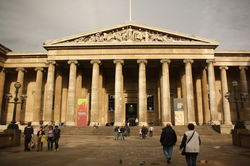
The exhibition examines the importance of the Hajj as one of the Five Pillars of Islam for Muslims and how this spiritual journey has changed over time.
No non-Muslims are welcome to observe the rituals described by the exhibition. Nor can they visit the sites. It is the sacred duty of all Muslims to complete the pilgrimage to Mecca. The rituals have remained the same for centuries. The exhibition displays ancient scrolls and more recent travel diaries, from the explorer Richard Burton, whose accounts of travelling in disguise in 1853 became a best seller.
But it’s the story of Lady Evelyn Cobbold that I find fascinating. Not interested in the princess exhibition? This lady ain’t no princess, as they say…
Lady Cobbold had spent many childhood winters in North Africa and it is during those visits she became familiar with Islam. After her marriage to John Dupius Cobbold in 1891 soured she turned to the place of her formative years, North Africa, for succour. The couple separated in 1922. She later wrote: "It seems that I have always been a Moslem."
Her interest did not develop into conversion until a visit to Italy, where some Italian friends organised an audience with the Pope. Lady Cobbold wrote:
"Of course I was thrilled. When His Holiness suddenly addressed me by asking if I was a Catholic I was taken aback for a moment then replied that I was a Moslem. What possessed me I don't pretend to know as I had not given a thought to Islam for many years. A match was lit and then and there I determined to read up and study the faith."
The Mayfair socialite changed her name to Zainab, sharing the name with the eldest daughter of the Prophet Mohammed.
In 1933 at the age of 65 Lady Cobbold made the required pilgrimage to Mecca and became the first British born Muslim woman to do so.
Lady Evelyn Cobbold died in 1963 aged 96. She was buried on her Scottish estate at Glencarron, Wester Ross.
The exhibition runs from 26 January to 15 April 2012
Admission charges apply
Squeamish Kate
 RSS Feed
RSS Feed
